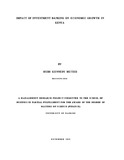| dc.description.abstract | Investment banks are an essential part of the financial sectors of modern economies. Providing alternative savings tools to savers and non-bank sources of financing for enterprises, the markets promote economic growth through improved efficiency in savings mobilization (Hunter, 2003).
Nevertheless, in an economy of many private enterprises, many firms list in the market while many that qualify to do so do not.
Capital market authorities may be unaware of plausible factors that induce firms to list in the market. Worse, they may be unaware of persisting negative factors that may inhibit qualified firms from listing in the stock exchange. The capital markets consist of the primary market and the secondary market. The primary markets are where new stock and bonds issues are sold (underwritten) to investors. The secondary markets are where existing securities are sold and bought from one investor or speculator to another, usually on an exchange.
This study was a descriptive study. According to Schinler and Coopers (2004) descriptive studies are more formalized and typically structured with clearly stated hypotheses or investigative questions. It serves a variety of research objectives such as descriptions of phenomenon or characteristics associated with a subject population, estimates of proportions of a population that have these characteristics and discovery of associations among different variables.
This study was carried on investment banks in Kenya and the population of the study was all the 23 investment banks in Kenya (CBK, 2008). Census was used in carrying out the study. The whole population was covered hence no sampling done. Secondary data was used in this study.
This was obtained from NSE database and included Gross Domestic Product measured as the real Gross Domestic Product generated within the year; average commission fee charged by the investment banks in Kenya; the total number of investment banks in Kenya within the year; The total value of stocks traded or transacted within the year; the trading cycle within the investment market to measure the microstructure of investment markets.
The study revealed that efficient investment banking in the general economy strives to; improve their capital bases, reduce operational costs, improve assets quality by reducing the rate of nonperforming loans, employ revenue diversification strategies as opposed to focused strategies and
keep the right amount of liquid assets. Indeed the descriptive analysis of these factors by number of investment banking showed that large investment banks perform better than the small and medium investment banks hence superior in their contribution to economic growth.
This study therefore, sought to establish the impact of investment banking on economic growth of Kenya. | en |

